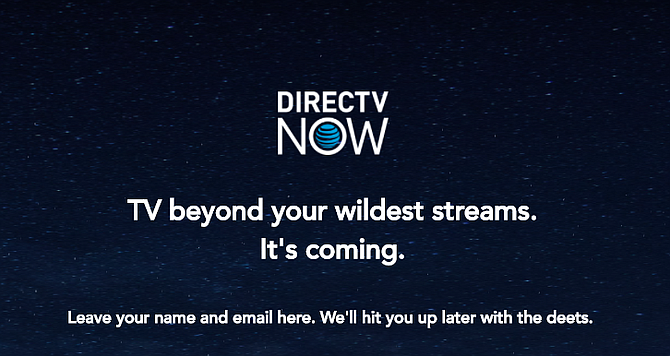NEW YORK (AP) — There are already a few online services that aim to replace cable, but they haven't attracted many users yet. AT&T's DirecTV hopes to change that with a new service announced Monday.
While just about any person you meet on the street will tell you cable costs too much, the vast majority of Americans don't think it's bad enough to cancel. Cheaper online live-TV services, like Dish Network's Sling TV and Sony's PlayStation Vue, remain relatively unknown compared with Netflix, Hulu and Amazon. And while they're easy to order and cancel online and fairly simple to use, they still have drawbacks.
"No one has really delivered the right combination of content, price and ease that will get people to make that call to their current provider and say sayonara," said Forrester analyst Jim Nail.
It's unclear if AT&T's new service, creatively dubbed DirecTV Now, will break out with consumers, especially with another live-TV operation from Hulu coming early next year. And maybe one from Google. Or, who knows, maybe even Apple, too.
The service, which will be available on Wednesday, will initially offer more than 100 channels for a teaser price of $35 a month. But that's a limited-time offer, and the price for that bundle will nearly double once the deal expires. (Existing customers will be grandfathered in.) AT&T didn't say when that will happen.
WHO WANTS TO WATCH?
If an online cable service could figure out how to get customers to pay up, it could attract millions of people.
Americans are increasingly dissatisfied with how much they pay for what's on TV. The number of customers paying cable and satellite operators for TV has dropped nearly 3 million, to roughly 97 million, in the past two years, according to industry experts MoffettNathanson Research.
And plenty of people never signed up for a $100 TV bundle to begin with. Research firm SNL Kagan estimates that about 14.4 million households pay for internet but not TV. AT&T sees the potential market for DirecTV Now as 20 million homes.
But analysts estimate that Sling has racked up fewer than 1 million subscribers since it launched in February 2015. Vue's numbers are harder to get a handle on, but it's not on the list of top 10 most popular online video services compiled by research firm Parks Associates. Neither service reports subscriber numbers.
Of course, it's hard to attract attention when there are also dozens of other video apps. You can sign up for specific sports, or comedy, or anime, or a single channel, like HBO or CBS. Netflix, the country's most popular paid video service, has 47.5 million customers in the U.S.
THE PROBLEMS WITH INTERNET TV
New services don't have all the channels people want. There's been no perfect solution that lets you pick only your favorite channels for a reasonable price, a vision of TV nirvana known as "a la carte" that has failed to materialize because it undermines the business models of entertainment conglomerates. Only people in some markets can watch broadcast channels like NBC and Fox in real time. That's OK if you can wait to watch the next episode of a TV series, but sports fans typically want to watch games live.
And even though so-called cord-cutters are on a quest for cheaper video, virtual cable may end costing just as much, depending on how many sports channels or other extras you want and how much your internet costs when it's disconnected from its cable-bundle discount. Bundles from Sling and Vue range from $20 to $65 a month. You can pay to add more channels.
These services are easy to sign up for and cancel — but connecting them to a TV often requires an extra step or a new gadget, like an Apple TV. On the plus side, while they've experienced some technical issues during major events, service quality appears to have improved.
And they sometimes lack some of the best features of both traditional TV, like endless channel options and DVR recording (which Vue offers now, while Sling is only launching next month) and subscription TV services like Amazon and Netflix (no blackouts, no restrictions based on location if you're in your home country).
ENTER DIRECTV
DirecTV Now, available Wednesday, will have some of those same problems. It is launching without CBS, which airs hits like "NCIS," ''The Big Bang Theory" and NFL football games. CBS also has its own streaming service it wants you to pay for.
And ABC, NBC and Fox will only be available live in a handful of mostly large cities — those in which the national broadcasters own its local TV affiliate. So lots of sports will be unavailable for many subscribers.
The service won't immediately offer an online DVR that lets you store programs online for later viewing, although AT&T says that will be coming next year. You can only run it on two screens at a time, which may not work for large families. And it won't work with Roku, one of the most popular streaming-TV gadgets.
Even so, the $35 bundle is cheaper than the typical cable bundle and provides more channels than online cable competitors offer at similar prices. But the $60 standard price that kicks in down the road is much less of a deal. AT&T will also offer a smaller package of about 60 channels for $35. There will also be $50 and $70 bundles.
AT&T will promote the service by letting its smartphone customers stream without eating into their mobile data plan.
Copyright Associated Press. All rights reserved. This material may not be published, broadcast, rewritten, or redistributed.


